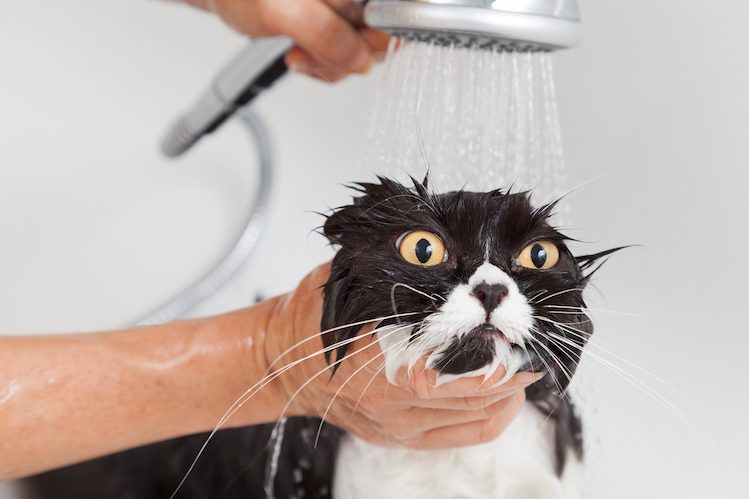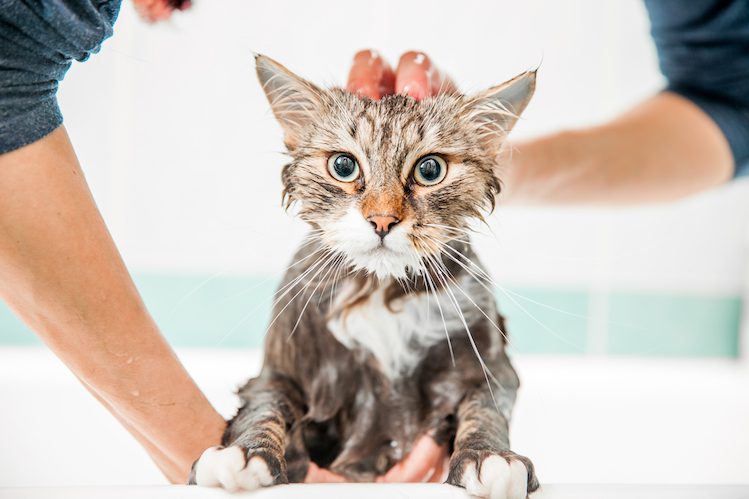
How to wash a cat that is afraid of water
Although cats are very clean and can take care of their coats on their own, they must be bathed at least once a month. However, for many owners, water procedures with a cat turn into real battles. We will find out why cats are afraid of water and what to do so that the pet does not react to bathing so emotionally.
Contents
Why wash a cat?
Licking a cat does not replace taking a bath. The fact is that the purr itself can only get rid of partial pollution and foreign smell, but this is not enough.
Felinologists and veterinarians say that cats should definitely be bathed. And here’s what for:
washing is the prevention of diseases;
pet skin is moisturized and cleansed, gets rid of dead epithelium;
all harmful substances that have settled on the fur coat are washed off;
dead hair is removed, so there will be much less of it in the cat’s stomach;
the coat becomes healthier, more beautiful and well-groomed.
Remember that cats do not need to be washed very often, because. Shampoo can remove the protective coating on your pet’s skin, which can lead to problems.
It is ideal to wash the cat once a month. Even if the cat never leaves the apartment, you need to wash it at least once every 2-3 months.

Why are cats afraid of water?
You can talk about the reasons for the cat’s fear of water for a long time, because this fear has many reasons.
Here are the most common ones:
water noise;
slippery bathroom floor
unsuitable water temperature;
unwillingness to be restricted in movement;
excitement, uncertainty of the owner, rude attitude.
In the next section, we will figure out how to bathe a cat if she is afraid of water, and how the owner should behave in order to minimize injury.
How to wash a cat that is afraid of water
Let’s move on to the most important thing: how to bathe a cat that can’t stand water.
1. Prepare all the necessary attributes for washing in advance so that they are at your fingertips.
2. Bathe your cat when she is in high spirits and in good health. If this is not the case, then it is better to postpone washing until better times.
3. It is advisable to enlist the support of another family member. Let him stroke, soothe and hold the cat while you wash it. Brute force and screaming are taboo.
4. On the eve of washing or before it, be sure to trim the cat’s claws, so you protect yourself from injury. While swimming, it is advisable to wear long sleeves. It’s inconvenient, but safe.
5. If the cat does not like water, pour it to such a level that it does not touch the pet’s stomach. You can level up over time.
6. Many owners find it more convenient to wash their wards under a tap or shower, but this scares the cats and makes them anxious. A hissing watering can or a tap can be mistaken for a living creature that wants to harm him. There is only one way out – to bathe the pet in a basin of water or in a bath, pouring water on the cat from a ladle. Try not to get the cat in the eyes, nose and ears with water or shampoo. Do not touch your head at all, let it remain dry.
7. Most cats are uncomfortable with wet fur, not only in terms of sensations, but also in terms of smell. Therefore, the pet will in every possible way avoid smelling this smell again. So the cat should be thoroughly dried with a towel to minimize the amount of moisture on the coat.
8. Regulating water, people rely on their own feelings, but this cannot be done. The body temperature of a cat is higher than human and is 37-39 degrees. Therefore, you need to bathe cats in water heated to 40 degrees. If the water is cooler, then the pet will be cold in it.
9. Not a single cat will like it if they try to force him to stay in one place. Especially if this place does not deliver positive emotions. Of course, you need to hold the pet, but do not hold on to it with a stranglehold. So he will be hurt.
10. Cats really don’t like it when they can’t stand firmly on their paws. The slippery surface of the bath causes them great discomfort. Therefore, it is imperative to put a towel or mat on the bottom of the bath.
11. It’s great if his favorite toys are in the bath with the cat. They will distract the pet and slightly improve his mood.
12. Do not hesitate to wash. Wetted the fur coat – immediately applied shampoo, lathered and washed off. Do it quickly but carefully. It is important to thoroughly rinse off the remnants of the shampoo.
13. With a long-haired cat, you can squeeze out excess water a little with your hands. Wrap your pet in a large terry towel.
14. Drying your pet with a hair dryer, although effective, is dangerous. The noise of the appliance can cause even more stress for the cat. But if the house is cool, it is better to sacrifice the calmness of the cat than his health, and still use a hair dryer.
15. Keep calm, because without it you will not be able to calm the cat. The pet sees that the person is agitated and annoyed, and he begins to get nervous. And if the owner also yells at the four-legged and makes sudden movements, then the cat will hurry to leave the bathroom as soon as possible. It is better to control yourself, talk kindly and kindly with your pet and try not to physically influence him.

Stock up on dry shampoo
Dry shampoo is a must have for cats who are not friendly with water. Although the use of dry shampoo is not a substitute for a full bath, sometimes it helps a lot. Dry shampoo is useful for removing local, small impurities or anywhere outside the home. And no stress for shy cats: no water, no noise, no foam. You don’t even need to dry!
Bathe your pets the right way! Then the washing procedure will take place more calmly and without injury for both parties.





